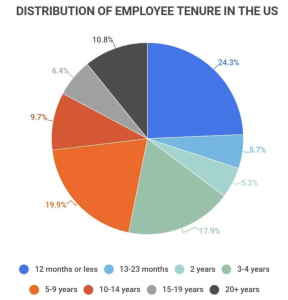In today’s non-stop business landscape, employee turnover is a reality that companies simply cannot afford to ignore.
The era of lifelong employment is long gone. It has been replaced by a fluid job market where career shifts are commonplace.
According to the Bureau of Labor Statistics, the average US worker will have held ten different jobs before they reach the age of 40, and this number is projected to grow. Forrester Research predicts that today’s youngest workers will hold 12-15 jobs in their lifetime.

(Sources – top: Zippia.com -2023)
Job tenure amongst 18-34 year old workers (Pew Research)

With high turnover rates only predicted to be ‘more’ likely, it’s clear a paradigm shift in how companies approach employee departures is needed – one that isn’t about the challenges turnover presents, but which is able to turn this seeming disadvantage into a strategic asset.
We believe this requires firms actually teaching employees ‘how to leave’ – because in doing so, it can actually be a means of fostering long-term loyalty and aligning individual career aspirations with the company’s goals.
The reality of high employee turnover
Let’s take a step back to understand why.
The modern workplace is encountering a high degree of mobility. Employees, especially younger workers, are increasingly viewing their careers as a series of experiences or “career acts” rather than a long-term commitment to an employer.
This mindset, while offering personal growth opportunities for employees, poses a significant challenge for companies seeking to retain talent and maintain a stable workforce.
Traditionally, companies have viewed unwanted employee departures negatively, often considering them a loss of investment in training and development.
However, this perspective overlooks the potential benefits of a more open and supportive approach to career transitions.
By assisting employees in their career self-development, even when it leads them outside the company, organizations can foster a more engaged and loyal workforce.
We advocate for a progressive approach where companies could potentially play a more active role in their employees’ career self-development, even while recognizing that this journey might lead them elsewhere.
This approach is grounded in the understanding that when employees feel their employer genuinely cares about their career growth, they’re more likely to be engaged and contribute positively to the company’s success.
Implementing a strategy to teach employees how to develop their own career journeys involves several key approaches:
Encouraging career exploration
Companies should encourage employees to explore various career paths and opportunities, even those outside the organization. This can be done through mentorship programs, career workshops, and providing access to resources for professional development.
Promoting skill development aligned with personal goals
Aligning skill development with an employee’s personal career goals can be mutually beneficial. By offering training that not only serves the company’s immediate needs but also helps employees build a portfolio of transferable skills, organizations can enhance employee satisfaction and loyalty.
Fostering a culture of open dialogue about career aspirations
Creating an environment where employees feel comfortable discussing their career aspirations, including those that may lead them away from the company, is crucial. This openness can lead to better alignment of the employee’s role and projects with their career objectives, benefiting both the individual and the organization.
Supporting transitional phases
Companies can offer support during the transition phase, such as counseling, networking opportunities, or assistance in identifying new roles. This support not only aids departing employee but also enhances the company’s reputation as a supportive and progressive employer.
Maintaining alumni networks
Establishing a strong alumni network helps maintain long-term relationships with former employees. These networks can be a valuable resource for business opportunities, partnerships, or for re-hiring former employees (boomerang employees) in new capacities.
Benefits of teaching employees how to transition
Among the many benefits of this approach , we believe teaching employees how to leave organizations gives:
Enhanced employee engagement:
When employees feel their personal and professional growth is valued, their engagement and productivity improve.
Positive employer branding:
A company known for supporting career development, even beyond its walls, attracts top talent.
Creation of ambassadors:
Former employees who felt valued and supported are likely to speak positively about their experience, creating a pool of informal ambassadors for the company.
Potential for boomerang employees:
Employees who leave on good terms are more likely to return in the future, bringing back enhanced skills and experiences.
Aligning career journeys with company’s wealth creation
So how do CHROs begin to achieve this?
To align individual career journeys with the company’s wealth creation, organizations must understand the key skills that contribute to their wealth creation and, in turn, promote the acquisition of those skills among employees.
This involves matching projects to employees’ development by assigning those projects that not only serve the company’s immediate needs but also align with the employee’s career interests and goals.
Additionally, fostering an environment where employees are encouraged to think ‘intrepreneurially’, aligns their career growth with innovation and value creation for the company.
This approach will generate natural win-wins.
Along the way, be sure to recognize and celebrate both individual and company successes, emphasizing how employee growth contributes to the organization’s achievements.
We encourage CHROs to provide tools for continuous employee learning.
When organizations do this, they’ll equip their employees with what they need to engage in career self-development and self-improvement while ensuring their skills remain relevant and valuable to the company.
Career self management
The concept of teaching employees how to leave is really about developing the skills of career self-management.
We believe that doing so offers a more realistic and strategic approach to dealing with the inevitability of employee turnover.
By embracing this approach, companies create a culture of continuous growth, mutual respect, and long-term loyalty.
This strategy not only benefits the employees in their career journey but also aligns their growth with the company’s objectives, creating a symbiotic relationship that fosters sustainable wealth creation and a positive organizational legacy.
Paula Caligiuri and Andy Palme are the co-authors of Live for a Living: How to Create Your Career Journey to Work Happier, Not Harder.
Employee turnover – the stats:

- The average person changes jobs 12 times in their lifetime.
- The average employee stays with their employer for 4.3 years (as of January 2022).
- Men hold 12.5 jobs in their lifetime, on average, while women have 12.1 jobs.
(Source: Zippia.com)

Source: VisualCapitalist (OliverWyman Gen Z Report 2023)
The view from….

John Baldino, CEO, Humareso
“Talent retention is more reactive than you realize”
“Studies show that a staggering 61% of employers struggle with retaining their workforce, but many employers still don’t proactively address the underlying issues that lead to people leaving.
And this reactive mindset, whether consciously acknowledged or not, can have detrimental effects on the organization’s bottom line, team dynamics, and overall productivity.
Understanding the root causes of talent loss is key for developing an effective retention strategy. Most of the common reasons for employee turnover include the lack of career development opportunities, poor work-life balance, and ineffective leadership and communication, though these areas do not represent all reasons for employee transition.
To build a comprehensive, non-reactive talent retention strategy, organizations must adopt a proactive approach focused on long-term investment in their workforce. This entails shifting the emphasis from speed-to-hire to quality hires that align with the organizational culture and values.
Organizations must redefine their philosophy when it comes to caring for their team, creating a positive and inclusive work culture that fosters employee development and well-being. This includes investing in professional growth opportunities, promoting work-life balance, and offering benefits to improve physical and mental health.
To no one’s surprise, talent retention is a critical aspect of organizational success. What may be new is the commitment to a proactive, holistic approach. By investing in a company’s workforce, fostering a positive work culture and addressing underlying issues, the mitigation of turnover rates and the improvement of employee satisfaction will occur. It’s time for organizations to shift from reactive measures to proactive strategies and reap the rewards of a performance-minded and engaged workforce.
